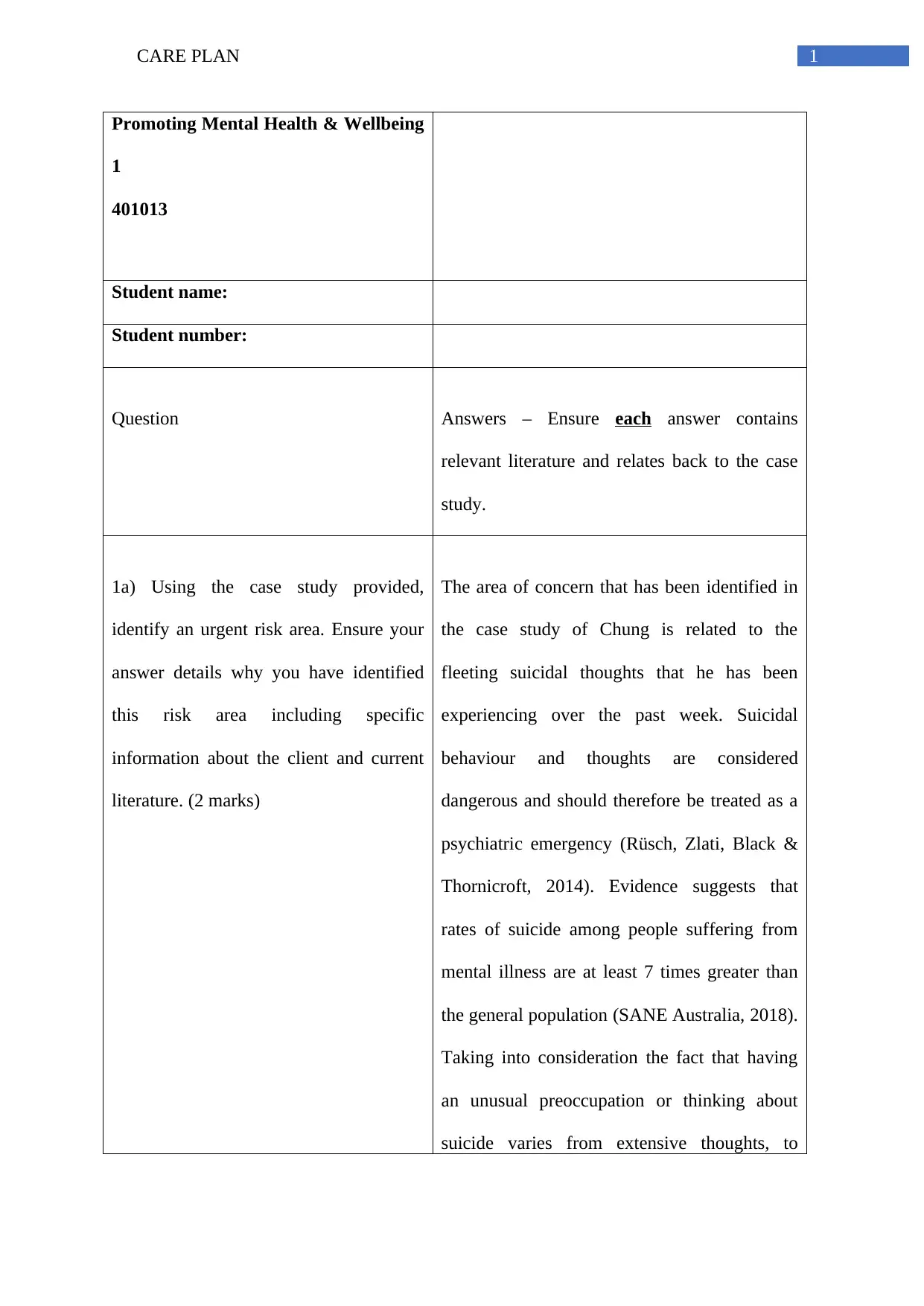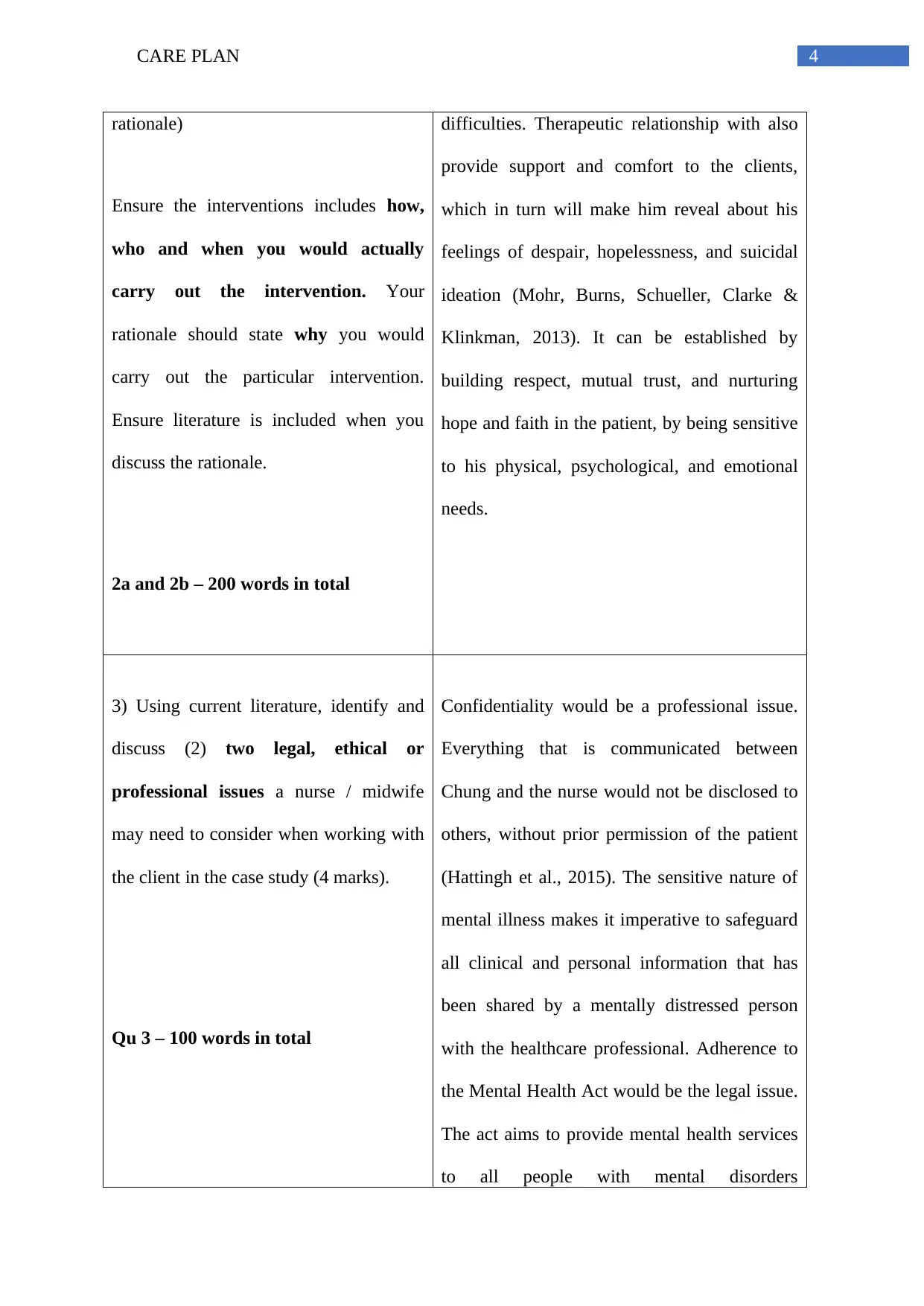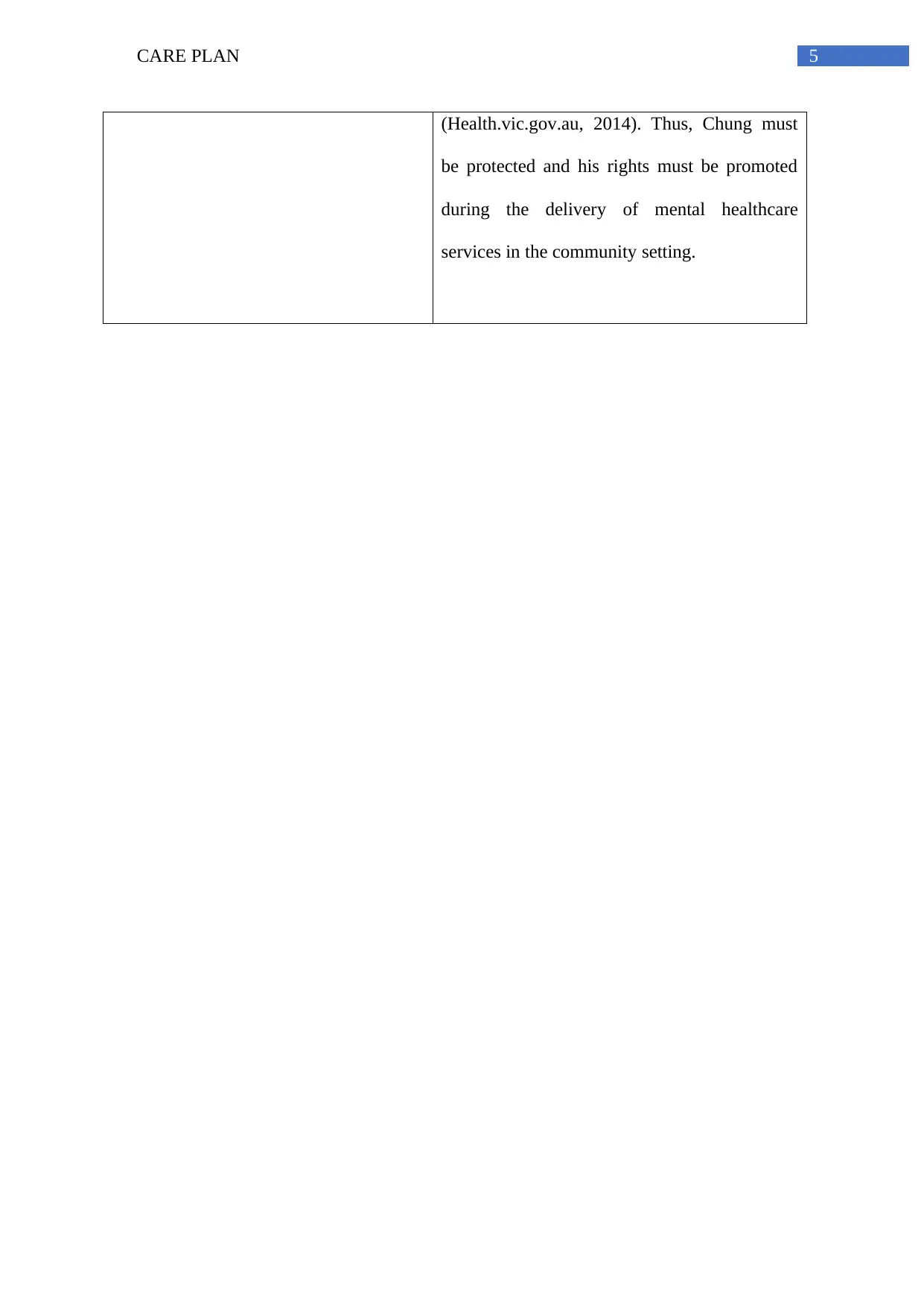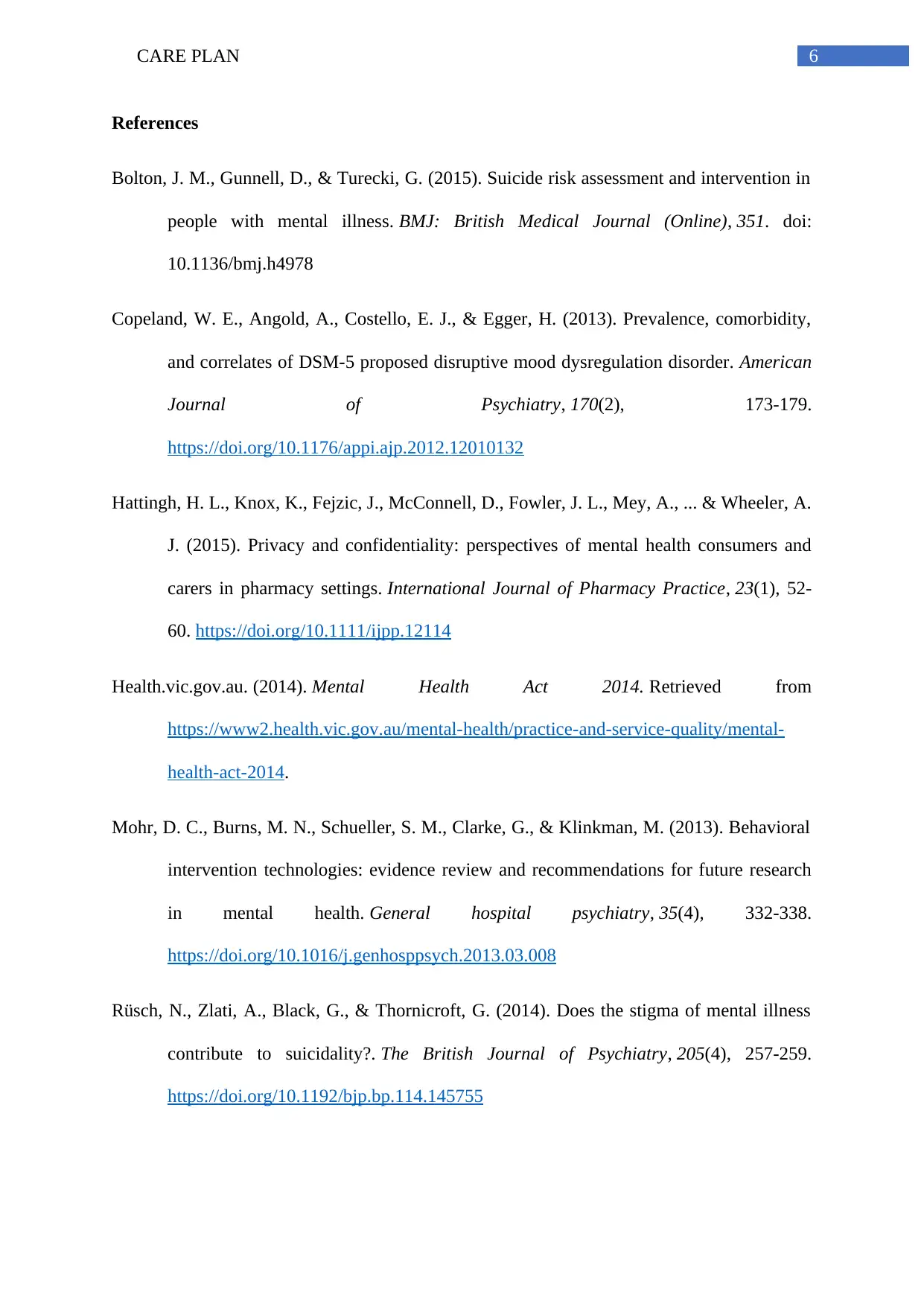401013 Promoting Mental Health: Anxiety Disorder Case Study Plan
VerifiedAdded on 2023/06/03
|8
|1334
|454
Case Study
AI Summary
This assignment presents a comprehensive care plan for a 35-year-old male doctor, Chung, experiencing anxiety disorder, low mood, and fleeting suicidal thoughts. The plan identifies urgent risk areas, such as suicidal ideation, and mental health concerns like persistent low mood. Key nursing interventions include conducting a suicide risk assessment and establishing a therapeutic relationship. The care plan also addresses legal, ethical, and professional considerations, such as confidentiality and adherence to the Mental Health Act. The assignment emphasizes the importance of integrating clinical judgment and evidence-based practices to promote the patient's mental health and well-being. This document is available on Desklib, a platform offering a wide range of study resources for students.

Running head: CARE PLAN
Bachelor of Nursing
Name of the Student
Name of the University
Author Note
Bachelor of Nursing
Name of the Student
Name of the University
Author Note
Paraphrase This Document
Need a fresh take? Get an instant paraphrase of this document with our AI Paraphraser

1CARE PLAN
Promoting Mental Health & Wellbeing
1
401013
Student name:
Student number:
Question Answers – Ensure each answer contains
relevant literature and relates back to the case
study.
1a) Using the case study provided,
identify an urgent risk area. Ensure your
answer details why you have identified
this risk area including specific
information about the client and current
literature. (2 marks)
The area of concern that has been identified in
the case study of Chung is related to the
fleeting suicidal thoughts that he has been
experiencing over the past week. Suicidal
behaviour and thoughts are considered
dangerous and should therefore be treated as a
psychiatric emergency (Rüsch, Zlati, Black &
Thornicroft, 2014). Evidence suggests that
rates of suicide among people suffering from
mental illness are at least 7 times greater than
the general population (SANE Australia, 2018).
Taking into consideration the fact that having
an unusual preoccupation or thinking about
suicide varies from extensive thoughts, to
Promoting Mental Health & Wellbeing
1
401013
Student name:
Student number:
Question Answers – Ensure each answer contains
relevant literature and relates back to the case
study.
1a) Using the case study provided,
identify an urgent risk area. Ensure your
answer details why you have identified
this risk area including specific
information about the client and current
literature. (2 marks)
The area of concern that has been identified in
the case study of Chung is related to the
fleeting suicidal thoughts that he has been
experiencing over the past week. Suicidal
behaviour and thoughts are considered
dangerous and should therefore be treated as a
psychiatric emergency (Rüsch, Zlati, Black &
Thornicroft, 2014). Evidence suggests that
rates of suicide among people suffering from
mental illness are at least 7 times greater than
the general population (SANE Australia, 2018).
Taking into consideration the fact that having
an unusual preoccupation or thinking about
suicide varies from extensive thoughts, to

2CARE PLAN
detailed planning and incomplete attempts, it
might put Chung’s life at risk and prove fatal.
1b) Identify one nursing / midwifery
intervention you would undertake
directly with your client to address the
risk area noted in question 1a and include
a rationale for the intervention. (2 marks
for the intervention and 2 marks for the
rationale)
Ensure the intervention includes how,
who and when you would actually carry
out the intervention. Your rationale
should state why you would carry out the
particular intervention. Ensure literature
is included.
1a and 1b – 200 words in total
One nursing intervention that would be taken in
this context is to conduct a suicide risk
assessment. Objective of this intervention to
would be to eliminate the probability of Chung
to commit suicide and would require
integration of clinical judgment along with
evidence-based practices. The different
components of this assessment would include
(1) engagement with the patient, (2) identifying
the major risk factors that force him to such
behaviour, (3) preliminary risk assessment
about collateral information and presenting
problems, (4) immediate management of
safety, conduction of a mental health, (5)
identifying the protective factors and assessing
mental state such as, psychosis, hopelessness,
and agitation, (6) management of the suicide
risk in the community, and (7) contingency
planning (Bolton, Gunnell & Turecki, 2015).
2a) Using the case study provided, One major mental health concern that has been
detailed planning and incomplete attempts, it
might put Chung’s life at risk and prove fatal.
1b) Identify one nursing / midwifery
intervention you would undertake
directly with your client to address the
risk area noted in question 1a and include
a rationale for the intervention. (2 marks
for the intervention and 2 marks for the
rationale)
Ensure the intervention includes how,
who and when you would actually carry
out the intervention. Your rationale
should state why you would carry out the
particular intervention. Ensure literature
is included.
1a and 1b – 200 words in total
One nursing intervention that would be taken in
this context is to conduct a suicide risk
assessment. Objective of this intervention to
would be to eliminate the probability of Chung
to commit suicide and would require
integration of clinical judgment along with
evidence-based practices. The different
components of this assessment would include
(1) engagement with the patient, (2) identifying
the major risk factors that force him to such
behaviour, (3) preliminary risk assessment
about collateral information and presenting
problems, (4) immediate management of
safety, conduction of a mental health, (5)
identifying the protective factors and assessing
mental state such as, psychosis, hopelessness,
and agitation, (6) management of the suicide
risk in the community, and (7) contingency
planning (Bolton, Gunnell & Turecki, 2015).
2a) Using the case study provided, One major mental health concern that has been
⊘ This is a preview!⊘
Do you want full access?
Subscribe today to unlock all pages.

Trusted by 1+ million students worldwide

3CARE PLAN
identify a mental health concern. Ensure
your answer details why you have
identified this concern including specific
information about the client and current
literature. (2 marks)
identified from the case study is persistent low
mood. Low mood includes worry, frustration,
sadness, and decreased self-esteem in a person.
Chung has been experiencing such low mood
since the birth of his child and problems at his
workplace. This mental illness has often been
associated with physical ailments and mental
anguish, and prevents people from carrying out
the activities of daily living (Copeland, Angold,
Costello & Egger, 2013). Taking into
consideration the fact that persistent low mood
can give rise to major depressive disorder in a
patient and facilitate the onset of fleeting
suicidal thoughts, there is a need to
immediately reduce the severity of the
condition to protect Chung.
2b) Identify one nursing / midwifery
intervention you would undertake
directly with your client to address the
mental health concern noted in question
2a and include a rationale for the
intervention. (2 marks for the
intervention and 2 marks for the
This can be addressed by establishing a
therapeutic relationship with Chung. Sound
mental health is largely dependent on the
presence of a therapeutic rapport between the
client and the nurse. It acts as the primary
intervention in promoting awareness and
assisting a patient, going through different
identify a mental health concern. Ensure
your answer details why you have
identified this concern including specific
information about the client and current
literature. (2 marks)
identified from the case study is persistent low
mood. Low mood includes worry, frustration,
sadness, and decreased self-esteem in a person.
Chung has been experiencing such low mood
since the birth of his child and problems at his
workplace. This mental illness has often been
associated with physical ailments and mental
anguish, and prevents people from carrying out
the activities of daily living (Copeland, Angold,
Costello & Egger, 2013). Taking into
consideration the fact that persistent low mood
can give rise to major depressive disorder in a
patient and facilitate the onset of fleeting
suicidal thoughts, there is a need to
immediately reduce the severity of the
condition to protect Chung.
2b) Identify one nursing / midwifery
intervention you would undertake
directly with your client to address the
mental health concern noted in question
2a and include a rationale for the
intervention. (2 marks for the
intervention and 2 marks for the
This can be addressed by establishing a
therapeutic relationship with Chung. Sound
mental health is largely dependent on the
presence of a therapeutic rapport between the
client and the nurse. It acts as the primary
intervention in promoting awareness and
assisting a patient, going through different
Paraphrase This Document
Need a fresh take? Get an instant paraphrase of this document with our AI Paraphraser

4CARE PLAN
rationale)
Ensure the interventions includes how,
who and when you would actually
carry out the intervention. Your
rationale should state why you would
carry out the particular intervention.
Ensure literature is included when you
discuss the rationale.
2a and 2b – 200 words in total
difficulties. Therapeutic relationship with also
provide support and comfort to the clients,
which in turn will make him reveal about his
feelings of despair, hopelessness, and suicidal
ideation (Mohr, Burns, Schueller, Clarke &
Klinkman, 2013). It can be established by
building respect, mutual trust, and nurturing
hope and faith in the patient, by being sensitive
to his physical, psychological, and emotional
needs.
3) Using current literature, identify and
discuss (2) two legal, ethical or
professional issues a nurse / midwife
may need to consider when working with
the client in the case study (4 marks).
Qu 3 – 100 words in total
Confidentiality would be a professional issue.
Everything that is communicated between
Chung and the nurse would not be disclosed to
others, without prior permission of the patient
(Hattingh et al., 2015). The sensitive nature of
mental illness makes it imperative to safeguard
all clinical and personal information that has
been shared by a mentally distressed person
with the healthcare professional. Adherence to
the Mental Health Act would be the legal issue.
The act aims to provide mental health services
to all people with mental disorders
rationale)
Ensure the interventions includes how,
who and when you would actually
carry out the intervention. Your
rationale should state why you would
carry out the particular intervention.
Ensure literature is included when you
discuss the rationale.
2a and 2b – 200 words in total
difficulties. Therapeutic relationship with also
provide support and comfort to the clients,
which in turn will make him reveal about his
feelings of despair, hopelessness, and suicidal
ideation (Mohr, Burns, Schueller, Clarke &
Klinkman, 2013). It can be established by
building respect, mutual trust, and nurturing
hope and faith in the patient, by being sensitive
to his physical, psychological, and emotional
needs.
3) Using current literature, identify and
discuss (2) two legal, ethical or
professional issues a nurse / midwife
may need to consider when working with
the client in the case study (4 marks).
Qu 3 – 100 words in total
Confidentiality would be a professional issue.
Everything that is communicated between
Chung and the nurse would not be disclosed to
others, without prior permission of the patient
(Hattingh et al., 2015). The sensitive nature of
mental illness makes it imperative to safeguard
all clinical and personal information that has
been shared by a mentally distressed person
with the healthcare professional. Adherence to
the Mental Health Act would be the legal issue.
The act aims to provide mental health services
to all people with mental disorders

5CARE PLAN
(Health.vic.gov.au, 2014). Thus, Chung must
be protected and his rights must be promoted
during the delivery of mental healthcare
services in the community setting.
(Health.vic.gov.au, 2014). Thus, Chung must
be protected and his rights must be promoted
during the delivery of mental healthcare
services in the community setting.
⊘ This is a preview!⊘
Do you want full access?
Subscribe today to unlock all pages.

Trusted by 1+ million students worldwide

6CARE PLAN
References
Bolton, J. M., Gunnell, D., & Turecki, G. (2015). Suicide risk assessment and intervention in
people with mental illness. BMJ: British Medical Journal (Online), 351. doi:
10.1136/bmj.h4978
Copeland, W. E., Angold, A., Costello, E. J., & Egger, H. (2013). Prevalence, comorbidity,
and correlates of DSM-5 proposed disruptive mood dysregulation disorder. American
Journal of Psychiatry, 170(2), 173-179.
https://doi.org/10.1176/appi.ajp.2012.12010132
Hattingh, H. L., Knox, K., Fejzic, J., McConnell, D., Fowler, J. L., Mey, A., ... & Wheeler, A.
J. (2015). Privacy and confidentiality: perspectives of mental health consumers and
carers in pharmacy settings. International Journal of Pharmacy Practice, 23(1), 52-
60. https://doi.org/10.1111/ijpp.12114
Health.vic.gov.au. (2014). Mental Health Act 2014. Retrieved from
https://www2.health.vic.gov.au/mental-health/practice-and-service-quality/mental-
health-act-2014.
Mohr, D. C., Burns, M. N., Schueller, S. M., Clarke, G., & Klinkman, M. (2013). Behavioral
intervention technologies: evidence review and recommendations for future research
in mental health. General hospital psychiatry, 35(4), 332-338.
https://doi.org/10.1016/j.genhosppsych.2013.03.008
Rüsch, N., Zlati, A., Black, G., & Thornicroft, G. (2014). Does the stigma of mental illness
contribute to suicidality?. The British Journal of Psychiatry, 205(4), 257-259.
https://doi.org/10.1192/bjp.bp.114.145755
References
Bolton, J. M., Gunnell, D., & Turecki, G. (2015). Suicide risk assessment and intervention in
people with mental illness. BMJ: British Medical Journal (Online), 351. doi:
10.1136/bmj.h4978
Copeland, W. E., Angold, A., Costello, E. J., & Egger, H. (2013). Prevalence, comorbidity,
and correlates of DSM-5 proposed disruptive mood dysregulation disorder. American
Journal of Psychiatry, 170(2), 173-179.
https://doi.org/10.1176/appi.ajp.2012.12010132
Hattingh, H. L., Knox, K., Fejzic, J., McConnell, D., Fowler, J. L., Mey, A., ... & Wheeler, A.
J. (2015). Privacy and confidentiality: perspectives of mental health consumers and
carers in pharmacy settings. International Journal of Pharmacy Practice, 23(1), 52-
60. https://doi.org/10.1111/ijpp.12114
Health.vic.gov.au. (2014). Mental Health Act 2014. Retrieved from
https://www2.health.vic.gov.au/mental-health/practice-and-service-quality/mental-
health-act-2014.
Mohr, D. C., Burns, M. N., Schueller, S. M., Clarke, G., & Klinkman, M. (2013). Behavioral
intervention technologies: evidence review and recommendations for future research
in mental health. General hospital psychiatry, 35(4), 332-338.
https://doi.org/10.1016/j.genhosppsych.2013.03.008
Rüsch, N., Zlati, A., Black, G., & Thornicroft, G. (2014). Does the stigma of mental illness
contribute to suicidality?. The British Journal of Psychiatry, 205(4), 257-259.
https://doi.org/10.1192/bjp.bp.114.145755
Paraphrase This Document
Need a fresh take? Get an instant paraphrase of this document with our AI Paraphraser

7CARE PLAN
SANE Australia. (2018). Suicidal behaviour. Retrieved from https://www.sane.org/mental-
health-and-illness/facts-and-guides/suicidal-behaviour.
SANE Australia. (2018). Suicidal behaviour. Retrieved from https://www.sane.org/mental-
health-and-illness/facts-and-guides/suicidal-behaviour.
1 out of 8
Related Documents
Your All-in-One AI-Powered Toolkit for Academic Success.
+13062052269
info@desklib.com
Available 24*7 on WhatsApp / Email
![[object Object]](/_next/static/media/star-bottom.7253800d.svg)
Unlock your academic potential
Copyright © 2020–2026 A2Z Services. All Rights Reserved. Developed and managed by ZUCOL.




